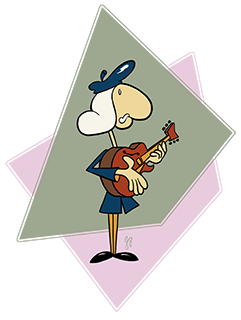Hold the pick slanting at an angle downward towards the floor. Do not hold the pick parallel to the length of the strings, nor perpendicular against the length of the strings. Hold the pick so its edge strikes at an angle. Also, as you are looking at the guitar straight on, the pointy end of the pick should be slightly above the the wide part the of pick. The pointy end should be more towards the low E and the wide part of the pick should be more towards the high E. It doesn't need to be exaggerated. This allows it to clear strings economically when moving to a new string. Try not to change this overall angle as you play. It should be consistent not matter what string you are playing on. The idea is to have the motion of the picking as identical as possible no matter where you are so you can essentially forget about it and concentrate on fretting notes.
Only move to another string on your upstroke. The upstroke (with the downward pick angle) naturally clears the pick from the strings; down-strokes trap the pick inside the strings.
Try to create even numbered 'chunks' of notes on each string. Create runs which are six notes long per string, or at least and even number of notes.
If necessary, use a pull-off in and odd-numbered 'chunk' to make sure you end on an upstroke. If you start picking on a down-stroke and need to play an odd number of notes on a string, use a pull-off (or try a slide, or hammer-on when ascending) to only pick and even number of notes and change strings on an upward stroke.
If you can't manufacture a pull-off to switch strings, use "sweep-picking." When it is impossible to use a slide, pull-off or hammer-on (e.g. only one note on string before moving to another string), allow the pick to continue in the same motion to the next string. This may require you to start a passage on an upstroke if a string in a passage only has one note.
Apocryhpa -- ways to solve things outside the Malsteem way:
Odd-numbered 'chunks' (e.g. three note per string runs) may also be solved with "two-way" pick slanting, if you don't want to use legato, pull-offs, slides, hammer-ons, etc. Two-way pick slanting is not in Yngwie's vocabulary, but a way others have solved the problem. Two-way pick slanting involves rocking the wrist so the pick slanting the opposite way, pointy-end towards the low E to clear a string in the other direction. It requires more thinking about the pick hand.
Instead of up-picking the first note of a run which has one note on one string, others use a finger.

 RSS Feed
RSS Feed
